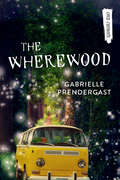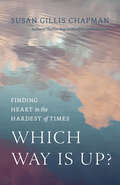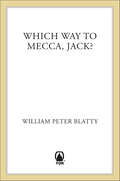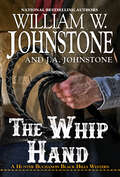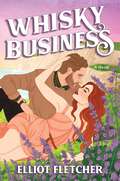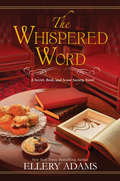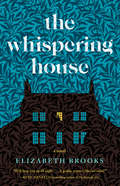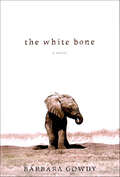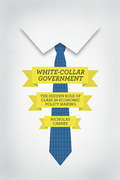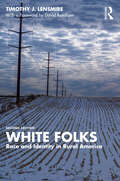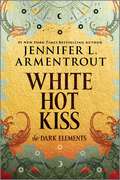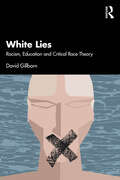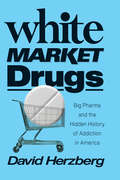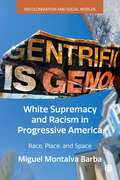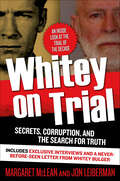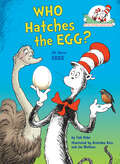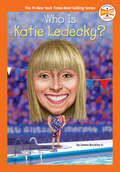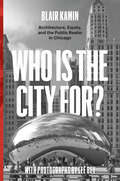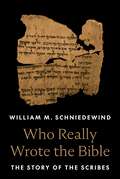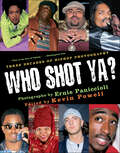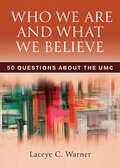- Table View
- List View
The Wherewood (Orca Currents)
by Gabrielle PrendergastFourteen-year-old Blue (a human) should be upset that his new friends Salix (a Nixie) and Finola (a Faerie) have tricked him into going on another adventure into the Faerieland. But he's actually quite excited. Especially since their quest to find the way back to Salix's homeland takes them through the Wherewood, a magical region where lost things go. They encounter confused pets, misplaced homework assignments and mountains of odd socks. But when a misstep leads Blue into the forsaken Witherwood, he comes face to face with an old enemy. And Olea, the cursed former queen of Nearwood, will not let Blue go so easily this time. This short novel is a high-interest, low-reading level book for middle-grade readers who are building reading skills, want a quick read or say they don’t like to read! This is the second book in the Faerie Woods series, following The Crosswood.
Which Way Is Up?: Finding Heart in the Hardest of Times
by Susan Gillis ChapmanA heartfelt guide for meeting difficult times with mindfulness, compassion, and courage—from a psychotherapist and Buddhist practitioner who learned from her own crisis.Features explorations of the three types of fear and practices to transform into opportunities for personal growth.This heartfelt guide transforms challenging times into surmountable journeys that we can emerge from by learning how to work with—rather than against—fear. Drawing from traditional Buddhist teachings on the bardo, a Tibetan word most often associated with the period between death and rebirth, Buddhist practitioner Susan Gillis Chapman offers guidance for those times when life seems to turn upside down. Amidst such difficulties—whether it&’s navigating the end of a relationship, a health scare, or other unexpected challenges—the fearful mind tends to panic. But Chapman, informed by her years working as psychotherapist, skillfully intercepts our uncertainty to show how we can let go of assumptions and allow something new to be reborn.Using personal examples from her own bardo crisis—navigating a cancer diagnosis during the pandemic—and offering contemplative prompts for inner-reflection and meditation practices throughout, she demystifies the main kinds of fear people experience and reveals how to meet them with love. This powerful resource will help restore equilibrium when life feels chaotic, and what&’s more, uncover truly transformative opportunities for personal growth in even the most difficult circumstances.
Which Way to Mecca, Jack?: From Brooklyn To Beirut: The Adventures Of An American Sheik
by William Peter BlattyBefore William Peter Blatty was the New York Times bestselling author of The Exorcist, he penned a series of comic articles for The Saturday Evening Post about his experiences in the Middle East. Which Way to Mecca, Jack?: From Brooklyn to Beirut: The Adventures of an American Sheik is his hilarious, semi-autobiographical story, based on the Post articles, originally inspired by his two-year stint in Lebanon working for the United States Information Agency.At the Publisher's request, this title is being sold without Digital Rights Management Software (DRM) applied.
The Whip Hand (A Hunter Buchanon Black Hills Western #4)
by William W. Johnstone J.A. JohnstoneJOHNSTONE COUNTRY. THE ULTIMATE KILLING GROUND.The latest action-packed installment in bestselling Western authors William W. Johnstone and J.A. Johnstone in the Hunter Buchanon Black Hills Western series.THE HILLS HAVE EYES The Buchanans are no strangers to hard times—or making hard choices. After losing a hefty number of livestock to a killer grizzly, Hunter Buchanan is forced to sell a dozen broncs down in Denver for some badly needed cash. Everything goes smoothly—until he&’s ambushed on the way home. The culprits are a murderous bunch of prairie rat outlaws, as dangerous as any Buchanan has ever tangled with. But Hunter is hell-bent on getting his money back. Even if means pursuing the thieves into Dakota Territory—where even deadlier dangers await . . . Meanwhile, Angus Buchanan has agreed to guide three former Confederate bounty hunters into the Black Hills, on the trail of six cutthroats who robbed a saloon and killed two men in Deadwood. This motley trio of hunters are as cutthroat as the cutthroats they&’re after. And it doesn&’t take long for Angus to realize they mean to slaughter him as well at the end of the trail . . . One family of ranchers. Two groups of cold-hearted murderers. So many ways to die.
Whisky Business: A Novel
by Elliot FletcherOpposites attract when a fish-out-of-water actress and a grumpy Scottish whisky distiller are forced to work together to save the business they both love.As a child, April Sinclair dreamt of escaping her quiet island life to become a world-famous actress. Now fully grown and with her once-flourishing career at an all-time low, what better way to figure out where it all went wrong than to go back to the beginning? April has her sights set on a new challenge, and that is saving her family’s distillery on the idyllic Scottish Isle of Skye. What she doesn’t expect to find is Malcolm Macabe, short-tempered and exceedingly attractive, living in the home she has just inherited. He may be a million miles away from the shy teenager she knew growing up, but one thing is for certain: he doesn’t want her around anymore.Master distiller Mal has three loves in his life: whisky, his dog, and silence. He has no time for the pampered princess poking her nose around his distillery, even if said princess is the one who got away. More comfortable in the shadows than the spotlight, Mal is content to wait her out. She’ll grow bored and run back to her glamorous world of nail salons and takeaway coffee eventually. When sparks begin to fly, he tells himself it doesn’t matter… because April Sinclair could never want a man like him, right?
The Whispered Word (A Secret, Book, and Scone Society Novel #2)
by Ellery AdamsIn this cozy mystery by a New York Times–bestselling author, a gifted bookstore owner can find the right book for any patron, but can she find a killer?The proprietor of Miracle Books in Miracle Springs, North Carolina, Nora Pennington believes that a well-chosen novel can bring healing and hope. But she and the other members of the Secret, Book, and Scone Society know that sometimes practical help is needed too. Such is the case with the reed-thin girl hiding in the fiction section of Nora&’s store, wearing a hospital ID and a patchwork of faded bruises. She calls herself Abilene but won&’t reveal much else. And when a customer is found dead in an assumed suicide, Nora uncovers a connection that points to Abilene as either a suspect—or another target. After a second death hits town, Nora and her intrepid friends must help the new, greenhorn sheriff discern fact from fiction—and stop a killer intent on bringing another victim&’s story to a close… &“A love letter to reading, with sharp characterizations and a smart central mystery.&”—Entertainment Weekly
The Whispering House
by Elizabeth Brooks"Eerie and addictive. . . . Like Wuthering Heights, The Whispering House is a melancholy novel, its characters filled with dark longings." — The New York Times Book Review From the acclaimed author of The Orphan of Salt Winds It was like holding a couple of jigsaw pieces in my palm, knowing there was a whole picture to be made, if I could only find the rest. Freya Lyell is struggling to move on from her sister Stella’s death five years ago. Visiting the bewitching Byrne Hall, only a few miles from the scene of the tragedy, she discovers a portrait of Stella—a portrait she had no idea existed, in a house Stella never set foot in. Or so she thought. Driven to find out more about her sister’s secrets, Freya is drawn into the world of Byrne Hall and its owners: charismatic artist Cory and his sinister, watchful mother. But as Freya lingers in this mysterious, centuries-old house, her relationship with Cory crosses the line into obsession and the darkness behind the locked doors of the estate threatens to spill out. In prose as lush and atmospheric as Byrne Hall itself, Elizabeth Brooks weaves a simmering, propulsive tale of art, sisterhood, and all-consuming love: the ways it can lead us toward tenderness, nostalgia, and longing, as well as shocking acts of violence.
The White Bone: A Novel
by Barbara GowdyA thrilling journey into the minds of African elephants as they struggle to survive. If, as many recent nonfiction bestsellers have revealed, animals possess emotions and awareness, they must also have stories. In The White Bone, a novel imagined entirely from the perspective of African elephants, Barbara Gowdy creates a world whole and separate that yet illuminates our own. For years, young Mud and her family have roamed the high grasses, swamps, and deserts of the sub-Sahara. Now the earth is scorched by drought, and the mutilated bodies of family and friends lie scattered on the ground, shot down by ivory hunters. Nothing-not the once familiar terrain, or the age-old rhythms of life, or even memory itself-seems reliable anymore. Yet a slim prophecy of hope is passed on from water hole to water hole: the sacred white bone of legend will point the elephants toward the Safe Place. And so begins a quest through Africa's vast and perilous plains-until at last the survivors face a decisive trial of loyalty and courage. In The White Bone, Barbara Gowdy performs a feat of imagination virtually unparalleled in modern fiction. Plunged into an alien landscape, we orient ourselves in elephant time, elephant space, elephant consciousness and begin to feel, as Gowdy puts it, "what it would be like to be that big and gentle, to be that imperiled, and to have that prodigious memory."
The White Circle: A Black Forest Investigation VI (The Black Forest Investigations #7)
by Oliver Bottini"A fitting and frightening conclusion to a magnificent series" The TimesThe final instalment of the acclaimed Black Forest Investigations brings the series to a shattering close.Louise Bonì, Chief Inspector of the Freiburg criminal police, gets intelligence from an informer that two guns have been bought from a Russian criminal network. Desperate to prevent a fatal act of violence, Bonì is swift to investigate. Before long she identifies the vehicle used to collect the weapons, but the car's owner has a watertight alibi. The man driving that night was Ricky Janisch, a neo-Nazi and member of the extreme right-wing group, the Southwest Brigade."Bottini is one of the most sophisticated crime writers of our times" JOAN SMITH, Sunday TimesBonì and her team put Janisch under surveillance, and identify others belonging to the extreme right. The further they probe, the more shocking their discoveries. Could this be part of a much more powerful neo-Nazi network which will stop at nothing? And how will they prevent an attack when the perpetrators are always a step ahead and they don't know the target? By the time Bonì pinpoints the victim, it may already be too late . . .Translated from the German by Jamie Bulloch
The White Circle: A Black Forest Investigation VI (The Black Forest Investigations #7)
by Oliver Bottini"A fitting and frightening conclusion to a magnificent series" The TimesThe final instalment of the acclaimed Black Forest Investigations brings the series to a shattering close.Louise Bonì, Chief Inspector of the Freiburg criminal police, gets intelligence from an informer that two guns have been bought from a Russian criminal network. Desperate to prevent a fatal act of violence, Bonì is swift to investigate. Before long she identifies the vehicle used to collect the weapons, but the car's owner has a watertight alibi. The man driving that night was Ricky Janisch, a neo-Nazi and member of the extreme right-wing group, the Southwest Brigade."Bottini is one of the most sophisticated crime writers of our times" JOAN SMITH, Sunday TimesBonì and her team put Janisch under surveillance, and identify others belonging to the extreme right. The further they probe, the more shocking their discoveries. Could this be part of a much more powerful neo-Nazi network which will stop at nothing? And how will they prevent an attack when the perpetrators are always a step ahead and they don't know the target? By the time Bonì pinpoints the victim, it may already be too late . . .Translated from the German by Jamie Bulloch
White-Collar Government: The Hidden Role of Class in Economic Policy Making (Chicago Studies In American Politics Ser.)
by Nicholas CarnesEight of the last twelve presidents were millionaires when they took office. Millionaires have a majority on the Supreme Court, and they also make up majorities in Congress, where a background in business or law is the norm and the average member has spent less than two percent of his or her adult life in a working-class job. Why is it that most politicians in America are so much better off than the people who elect them— and does the social class divide between citizens and their representatives matter? With White-Collar Government, Nicholas Carnes answers this question with a resounding—and disturbing—yes. Legislators’ socioeconomic backgrounds, he shows, have a profound impact on both how they view the issues and the choices they make in office. Scant representation from among the working class almost guarantees that the policymaking process will be skewed toward outcomes that favor the upper class. It matters that the wealthiest Americans set the tax rates for the wealthy, that white-collar professionals choose the minimum wage for blue-collar workers, and that people who have always had health insurance decide whether or not to help those without. And while there is no one cause for this crisis of representation, Carnes shows that the problem does not stem from a lack of qualified candidates from among the working class. The solution, he argues, must involve a variety of changes, from the equalization of campaign funding to a shift in the types of candidates the parties support. If we want a government for the people, we have to start working toward a government that is truly by the people. White-Collar Government challenges long-held notions about the causes of political inequality in the United States and speaks to enduring questions about representation and political accountability.
White Folks: Race and Identity in Rural America (ISSN)
by Timothy J. LensmireWhite Folks explores the experiences and stories of eight white people from a small farming community in northern Wisconsin. Drawing on in-depth interviews with Delores, Frank, William, Erin, Robert, Libby, and Stan, as well as on his own experiences growing up in this same rural community, Lensmire creates a portrait of white people that highlights the profound ambivalence that has characterized white thinking and feeling in relation to people of color for at least the last two hundred years. White people’s relations to people of color and their cultures are characterized not just by fear, rejection, and violence, but also by attraction, envy, and desire. There is nothing smooth about the souls of white folks.This second edition of White Folks features a new foreword—by renowned critical whiteness studies scholar David Roediger—that places the book in historical and political context. It also includes an expanded discussion by Lensmire on doing research on race with white people.
White Hot Kiss: The Dark Elements (The Dark Elements #1)
by Jennifer L. ArmentroutOne kiss could be enough to kill in the first book in the fan-favorite Dark Elements trilogy, from the #1 New York Times bestselling author of the Blood and Ash series. Seventeen-year-old Layla just wants to be normal—fit in at school and go out on a real date with the gorgeous Zayne, who she's crushed on since forever. Trouble is, Zayne treats Layla like a sister—and Layla is anything but normal. She's half demon, half gargoyle, with abilities no one else possesses. And even though Zayne is a Warden, part of the race of gargoyles tasked with hunting demons and keeping humanity safe, Layla's kiss will kill anything with a soul—including him. Then she meets Roth—a tattooed, sinfully hot demon who claims to know her secrets. Though Layla knows she should stay away, it&’s tough when that whole no-kissing thing isn't an issue. Trusting Roth could ruin her chances with Zayne—and brand her a traitor to the Warden family that raised her. But as Layla discovers she's the sole reason for a violent demon uprising, kissing the enemy suddenly pales in comparison to the looming end of the world.The Dark ElementsBook 1: White Hot KissBook 2: Stone Cold TouchBook 3: Every Last Breath
White Lies: Racism, Education and Critical Race Theory
by David GillbornUnpacking Critical Race Theory (CRT) and exploring why it has become a focus in politics across the US and the UK, White Lies uses CRT to expose the systemic racism that shapes education. It charts the coordinated campaigns – involving think tanks, mainstream media and politicians – that have tried to silence antiracism in the wake of George Floyd's murder and 'Black Lives Matter'.Each chapter is devoted to exposing a key ‘white lie’ by examining the evidence that shows how the interests of white people continue to occupy centre stage and block movement towards a more equitable education for all. Gillborn establishes how the public debates, shaped by misinformation and 'white lies', sustain race inequity and portray antiracism as a threat to freedom and justice. Key controversies are dissected and debunked, including: the extensive and coordinated anti-CRT campaigns in the US and the UK; the use of racial gaslighting to undermine claims to social justice; how multiple forms of intimidation are used to silence antiracist teaching and protest; the inaccurate portrayal of the white working class as race victims; and how cruelty, in policy, aims to unify whites and demonize minorities. By avoiding unnecessary jargon to make complex debates accessible to a wide audience, this book is ideal reading for anyone studying CRT or interested in the topic of contemporary educational equality.
White Market Drugs: Big Pharma and the Hidden History of Addiction in America
by David HerzbergThe contemporary opioid crisis is widely seen as new and unprecedented. Not so. It is merely the latest in a long series of drug crises stretching back over a century. In White Market Drugs, David Herzberg explores these crises and the drugs that fueled them, from Bayer’s Heroin to Purdue’s OxyContin and all the drugs in between: barbiturate “goof balls,” amphetamine “thrill pills,” the “love drug” Quaalude, and more. As Herzberg argues, the vast majority of American experiences with drugs and addiction have taken place within what he calls “white markets,” where legal drugs called medicines are sold to a largely white clientele. These markets are widely acknowledged but no one has explained how they became so central to the medical system in a nation famous for its “drug wars”—until now. Drawing from federal, state, industry, and medical archives alongside a wealth of published sources, Herzberg re-connects America’s divided drug history, telling the whole story for the first time. He reveals that the driving question for policymakers has never been how to prohibit the use of addictive drugs, but how to ensure their availability in medical contexts, where profitability often outweighs public safety. Access to white markets was thus a double-edged sword for socially privileged consumers, even as communities of color faced exclusion and punitive drug prohibition. To counter this no-win setup, Herzberg advocates for a consumer protection approach that robustly regulates all drug markets to minimize risks while maintaining safe, reliable access (and treatment) for people with addiction. Accomplishing this requires rethinking a drug/medicine divide born a century ago that, unlike most policies of that racially segregated era, has somehow survived relatively unscathed into the twenty-first century. By showing how the twenty-first-century opioid crisis is only the most recent in a long history of similar crises of addiction to pharmaceuticals, Herzberg forces us to rethink our most basic ideas about drug policy and addiction itself—ideas that have been failing us catastrophically for over a century.
White Poverty: How Exposing Myths About Race and Class Can Reconstruct American Democracy
by William J. Barber IIA generational work with far-ranging social and political implications, White Poverty, promises to be one of the most influential books in recent years. One of the most pernicious and persistent myths in the United States is the association of Black skin with poverty. Though there are forty million more poor white people than Black people, most Americans, both Republicans and Democrats, continue to think of poverty—along with issues like welfare, unemployment, and food stamps—as solely a Black problem. Why is this so? What are the historical causes? And what are the political consequences that result? These are among the questions that the Reverend Dr. William J. Barber II, a leading advocate for the rights of the poor and the “closest person we have to Dr. King” (Cornel West), addresses in White Poverty, a groundbreaking work that exposes a legacy of historical myths that continue to define both white and Black people, creating in the process what might seem like an insuperable divide. Analyzing what has changed since the 1930s, when the face of American poverty was white, Barber, along with Jonathan Wilson-Hartgrove, addresses white poverty as a hugely neglected subject that just might provide the key to mitigating racism and bringing together tens of millions of working class and impoverished Americans. Thus challenging the very definition of who is poor in America, Barber writes about the lies that prevent us from seeing the pain of poor white families who have been offered little more than their “whiteness” and angry social media posts to sustain them in an economy where the costs of housing, healthcare, and education have skyrocketed while wages have stagnated for all but the very rich. Asserting in Biblically inspired language that there should never be shame in being poor, White Poverty lifts the hope for a new “moral fusion movement” that seeks to unite people “who have been pitted against one another by politicians (and billionaires) who depend on the poorest of us not being here.” Ultimately, White Poverty, a ringing work that braids poignant autobiographical recollections with astute historical analysis, contends that tens of millions of America’s poorest earners, the majority of whom don’t vote, have much in common, thus providing us with one of the most empathetic and visionary approaches to American poverty in decades.
White Supremacy and Racism in Progressive America: Race, Place, and Space (Decolonization and Social Worlds)
by Miguel Montalva BarbaThis book examines the connections between race, place, and space, and sheds light on how they contribute and maintain racial hierarchies. The author focuses on the White residents of Jamaica Plain, Massachusetts, which, according to the Cooks Political Report Partisan Voting Index, is the most liberal district in the state and 15th in the United States of America. The book uses settler colonialism and critical race theory to explore how self-identified progressive White residents perceive their gentrifying neighborhood and how they make sense of their positionality. Using the extended case method, as well as in-depth interviews, participant observation, content analysis and visual/media analysis, the author reveals how systemic racialized inequality persists even in a politically progressive borough.
Whitey on Trial: Secrets, Corruption, and the Search for Truth
by Margaret McLean Jon LeibermanAfter sixteen years on the lam, infamous Boston gangster Whitey Bulger was finally captured and brought to trial-and what a trial it was: evidence of nineteen gruesome murders, government secrets, FBI corruption, a dead witness, and an unbelievable tale of love. Whitey's machine guns and gangland-style extortions gripped the city of Boston for decades.Investigative journalist Jon Leiberman travelled the world with the FBI's Whitey Bulger task force. Former Boston area prosecutor and legal analyst Margaret McLean witnessed every day of testimony, heard every word uttered in court. Both authors have developed close relationships with the investigators, the lawyers, and Whitey's friends, his fellow mobsters, his victims and their families.In Whitey on Trial, the truth is revealed through trial testimony, interviews with cops, FBI agents, prosecutors and defense attorneys, and members of the jury that ultimately found Bulger guilty on thirty-one counts, including eleven murders. An exclusive letter from Whitey to McLean offers insight into his state of mind immediately following the verdict. Whitey on Trial is the definitive firsthand account of the Whitey Bulger trial.At the Publisher's request, this title is being sold without Digital Rights Management Software (DRM) applied.
Who Hatches the Egg? All About Eggs: All About Eggs (The Cat in the Hat's Learning Library)
by Tish RabeLaugh and learn with fun facts about eggs and the different kinds of animals that lay them—all told in Dr. Seuss&’s beloved rhyming style and starring The Cat in the Hat! &“I&’m the Cat in the Hat. We must leave right away. Can you guess what I&’m cooking for breakfast today!&” The Cat in the Hat&’s Learning Library series combines beloved characters, engaging rhymes, and Seussian illustrations to introduce children to non-fiction topics from the real world! Crack open the science of eggs and discover: • how all birds, insects, and spiders all lay eggs• how most amphibians, fish, and reptiles also lay eggs• the amazing shapes, sizes, and colors they come in• and much more! Perfect for story time and for the youngest readers, Who Hatches the Egg? also includes an index, glossary, and suggestions for further learning. Look for more books in the Cat in the Hat&’s Learning Library series!Cows Can Moo! Can You? All About FarmsHark! A Shark! All About SharksIf I Ran the Dog Show: All About DogsOh Say Can You Say Di-no-saur? All About DinosaursOn Beyond Bugs! All About InsectsOne Vote Two Votes I Vote You VoteThere&’s No Place Like Space: All About Our Solar SystemWhy Oh Why Are Deserts Dry? All About DesertsWish for a Fish: All About Sea Creatures
Who Is Katie Ledecky? (Who HQ Now)
by James Buckley Who HQLearn how a young girl who loved being in the water became one of the greatest Olympic swimmers of all time in this exciting addition to the Who HQ Now series featuring newsmakers and trending topics.Katie Ledecky began swimming competitively at age six after watching her mother and brother in the pool. By age fifteen, she was setting records and winning gold medals at the 2012 Summer Olympics. And with each year, Katie improved her skills and her times in the water! The Summer 2024 Olympics in Paris will be Katie's fourth, and the world will be watching.With over seven Olympic gold medals, nineteen World Championship gold medals, and twenty-two overall medals at the World Aquatics Championships to her name, Katie has become the most decorated female swimmer in the world. Her charming spirit and impressive athletic skills have made Katie a popular role model for young swimmers, and everyone is eager to see what she achieves in the future.
Who Is the City For?: Architecture, Equity, and the Public Realm in Chicago
by Blair KaminA vividly illustrated collaboration between two of Chicago’s most celebrated architecture critics casts a wise and unsparing eye on inequities in the built environment and attempts to rectify them. From his high-profile battles with Donald Trump to his insightful celebrations of Frank Lloyd Wright and front-page takedowns of Chicago mega-projects like Lincoln Yards, Pulitzer Prize–winning architecture critic Blair Kamin has long informed and delighted readers with his illuminating commentary. Kamin’s newest collection, Who Is the City For?, does more than gather fifty-five of his most notable Chicago Tribune columns from the past decade: it pairs his words with striking new images by photographer and architecture critic Lee Bey, Kamin’s former rival at the Chicago Sun-Times. Together, they paint a revealing portrait of Chicago that reaches beyond its glamorous downtown and dramatic buildings by renowned architects like Jeanne Gang to its culturally diverse neighborhoods, including modest structures associated with storied figures from the city’s Black history, such as Emmett Till. At the book’s heart is its expansive approach to a central concept in contemporary political and architectural discourse: equity. Kamin argues for a broad understanding of the term, one that prioritizes both the shared spaces of the public realm and the urgent need to rebuild Black and brown neighborhoods devastated by decades of discrimination and disinvestment. “At best,” he writes in the book’s introduction, “the public realm can serve as an equalizing force, a democratizing force. It can spread life’s pleasures and confer dignity, irrespective of a person’s race, income, creed, or gender. In doing so, the public realm can promote the social contract — the notion that we are more than our individual selves, that our common humanity is made manifest in common ground.” Yet the reality in Chicago, as Who Is the City For? powerfully demonstrates, often falls painfully short of that ideal.
Who Really Wrote the Bible: The Story of the Scribes
by William M. SchniedewindA groundbreaking new account of the writing of the Hebrew BibleWho wrote the Bible? Its books have no bylines. Tradition long identified Moses as the author of the Pentateuch, with Ezra as editor. Ancient readers also suggested that David wrote the psalms and Solomon wrote Proverbs and Qohelet. Although the Hebrew Bible rarely speaks of its authors, people have been fascinated by the question of its authorship since ancient times. In Who Really Wrote the Bible, William Schniedewind offers a bold new answer: the Bible was not written by a single author, or by a series of single authors, but by communities of scribes. The Bible does not name its authors because authorship itself was an idea enshrined in a later era by the ancient Greeks. In the pre-Hellenistic world of ancient Near Eastern literature, books were produced, preserved, and passed on by scribal communities.Schniedewind draws on ancient inscriptions, archaeology, and anthropology, as well as a close reading of the biblical text itself, to trace the communal origin of biblical literature. Scribes were educated through apprenticeship rather than in schools. The prophet Isaiah, for example, has his &“disciples&”; Elisha has his &“apprentice.&” This mode of learning emphasized the need to pass along the traditions of a community of practice rather than to individuate and invent. Schniedewind shows that it is anachronistic to impose our ideas about individual authorship and authors on the writing of the Bible. Ancient Israelites didn&’t live in books, he writes, but along dusty highways and byways. Who Really Wrote the Bible describes how scribes and their apprentices actually worked in ancient Jerusalem and Judah.
Who Shot Ya?: Three Decades of HipHop Photography
by Ernie PaniccioliNearly thirty years ago, Ernie Paniccioli, considered by many to be the James Van Der Zee of the hiphop generation, began photographing graffiti art throughout New York City as well as the young people creating it. Armed with a 35-millimeter camera, Paniccioli literally recorded the beginning salvos of hiphop, today the most dominant youth culture on the planet. Be it Grandmaster Flash at the Roxy, a summer block party in the Bronx, the fresh faces of Jay-Z and Will Smith, the cocksure personas of Tupac Shakur, The Notorious B.I.G., and Eminem, or the regal grace of Lauryn Hill, Ernie Paniccioli has been there to showcase hiphop’s emerging talent.With more than 200 photographs that have been culled from a vast archive, Who Shot Ya? is the first major pictorial history of hiphop culture.
Who We Are and What We Believe: 50 Questions about the UMC
by Laceye C. WarnerClear answers to common questions.This small, simple, and shareable book about The United Methodist Church is a helpful reference guide to everything that makes The UMC distinctive. Written in a clear, accessible style by Laceye Warner, Who We Are and What We Believe: 50 Questions about the UMC contains answers to fifty common questions about who United Methodists are, what we believe and practice, and what sets us apart. Use it alone or as a companion to Knowing Who We Are: The Wesleyan Way of Grace.
Who We Be: The Colorization of America
by Jeff ChangRace. A four-letter word. The greatest social divide in American life, a half-century ago and today.During that time, the U.S. has seen the most dramatic demographic and cultural shifts in its history, what can be called the colorization of America. But the same nation that elected its first Black president on a wave of hope—another four-letter word—is still plunged into endless culture wars. How do Americans see race now? How has that changed—and not changed—over the half-century? After eras framed by words like "multicultural" and "post-racial," do we see each other any more clearly? Who We Be remixes comic strips and contemporary art, campus protests and corporate marketing campaigns, Martin Luther King, Jr. and Trayvon Martin into a powerful, unusual, and timely cultural history of the idea of racial progress. In this follow-up to the award-winning classic Can't Stop Won't Stop: A History of the Hip-Hop Generation, Jeff Chang brings fresh energy, style, and sweep to the essential American story.
